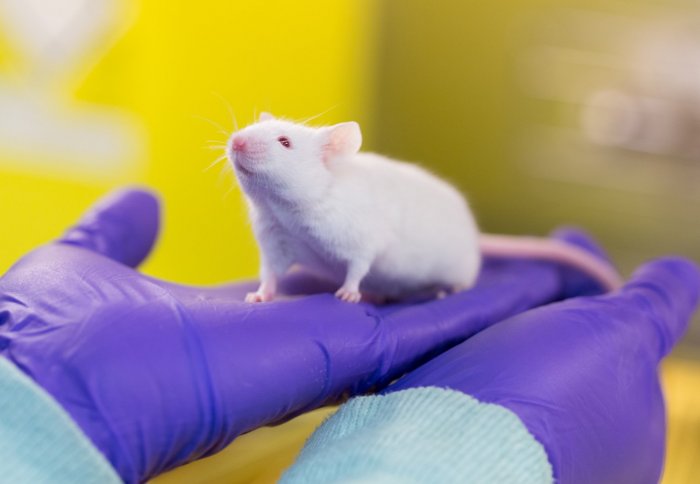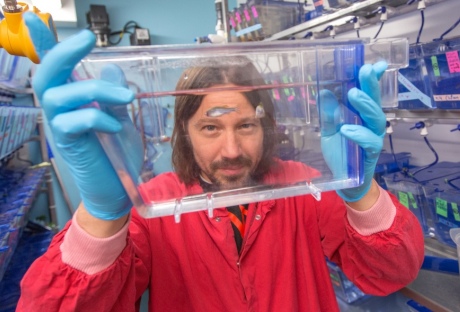Animal research annual report launched by Imperial
by Kate Wighton

Imperial College London have published their 2016 annual report into animal research.
The 30-page report, launched this week, gives an overview of animal research at the College, and outlines how this work is translating into benefits for both people and animals.
One project explored in the report is that of Professor Matthew Pickering, whose work with mice has led to a new treatment for patients affected by a group of rare kidney diseases called complement-mediated glomerulopathies.
This annual research report highlights the transformative impact our work involving animals is having in a number of areas of scientific research
– Professor James Stirling
Provost, Imperial College London
In particular, his team focus on a type of illness associated with the condition that triggers dangerous blood clots in the kidney. Using mouse models of the illness, they were able to see the condition was triggered by a particular protein. The Imperial scientists were then able to find an existing treatment that prevents activation of this protein – and this medicine is now used in patients.
Professor Pickering explained that choosing how many mice to use in research requires careful consideration: "It's about asking how we can do the experiments using the number of animals that will give us the answers we need, and no more."
Further work highlighted in the report involves fruit flies, which share 60 per cent of their genes with humans. Using them to study physiological changes has opened up new lines of research, and reduced the need to work with higher animal models such as mice.
Among the findings made by Professor Irene Miguel-Aliaga and her team are insights into how the gut adapts to malnutrition, and why men and women seem to suffer from different types of cancers.
Elsewhere, Imperial scientists are studying zebrafish to gain insights into how the immune system fights bacteria. Young zebrafish are completely transparent, which means scientists can visualise changes in their cells and organs in incredible detail.
Dr Serge Mostowy leads a team studying Shigella flexneri, which kills around one million people a year. The bacteria are increasingly developing resistance to antibiotics, and the researchers are working with zebrafish to develop alternatives to antibiotics.

Dr Serge Mostowy with zebrafish
Dr Mostowy said: “There are fantastic scientists using the mouse model, but they cannot see what we can see using the zebrafish model. What you can see is absolutely remarkable – not only at the whole animal level, but you can look at the single cell level, the single bacterium level, and you can do this in a living organism, in real time."
Work at Imperial is also improving the health of animals, as well as humans.
In one project, researchers’ work with amphibian species in the laboratory and in the field is helping with efforts to save frogs and toads around the globe from a deadly, skin-eating fungus.
The annual report also contains interviews with the teams responsible for the day-to-day animal care and well-being, including the technicians, veterinary surgeon, and the Director of Bioservices Professor Marina Botto.
Professor Botto, who is Imperial’s first Director of Bioservices, a position created under the College's Action Plan for Animal Research, said: "Being an academic I know how important it is to create the right environment for the welfare of the animals and the research. I want to make sure we continue to provide facilities that have high standards of welfare for our animals and can deliver the best science for our researchers. These will be the indicators of success."
The report also details the technological advances helping scientists reduce the number of animals they use in research.
For instance, the College's new Biological Imaging Centre combines the latest scanning techniques such as MRI and PET. Some of the techniques offered, such as biophototonic imaging, are specifically designed for animal studies.
Eric Aboagye, Professor of Cancer and Molecular Imaging at Imperial and a champion of the new centre explained: "The critical thing is that we can generate more data from the same animal, or use smaller numbers of animals to get the same amount of data, without compromising data."
Commenting on the overall report, Professor James Stirling, Provost of Imperial College London, said: "This annual research report highlights the transformative impact our work involving animals is having in a number of areas of scientific research. Thanks to the tireless work of the teams involved in animal research, we are continually building on our strengths and refinement, reduction and replacement. We now have the structures and systems in place to focus on what we do best: excellent science."
Article text (excluding photos or graphics) © Imperial College London.
Photos and graphics subject to third party copyright used with permission or © Imperial College London.
Reporter
Kate Wighton
Communications Division